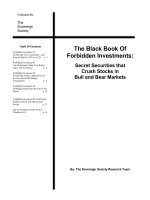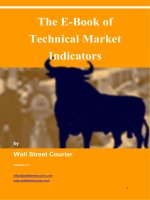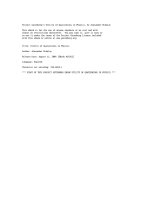The Project Gutenberg E Book of The Pig, by Sanders Spencer pdf
Bạn đang xem bản rút gọn của tài liệu. Xem và tải ngay bản đầy đủ của tài liệu tại đây (1.78 MB, 440 trang )
The Project Gutenberg EBook of The Pig, by
Sanders Spencer
This eBook is for the use of anyone
anywhere at no cost and with
almost no restrictions whatsoever. You may
copy it, give it away or
re-use it under the terms of the Project
Gutenberg License included
with this eBook or online at
www.gutenberg.net
Title: The Pig
Breeding, Rearing, and Marketing
Author: Sanders Spencer
Release Date: July 4, 2010 [EBook #33074]
Language: English
*** START OF THIS PROJECT GUTENBERG EBOOK
THE PIG ***
Produced by Steven Giacomelli, Simon
Gardner and the Online
Distributed Proofreading Team at
(This
file was produced from images produced by
Core Historical
Literature in Agriculture (CHLA), Cornell
University)
Frontispiece.
Photo, Reid, Wishaw.
BREEDING SOWS OF THE LARGE
AND MIDDLE WHITE BREEDS.
The Middle White Sow in the forefront
(the property of the Author) was one of
the best ever bred, "Holywell Countess
Victoria."
THE PIG
BREEDING, REARING, AND
MARKETING
BY
SANDERS SPENCER
London
C. Arthur Pearson Ltd.
Henrietta Street
1919
CONTENTS
CHAPTER PAGE
Introduction 13
I. Non-Pedigree Pigs 19
II.
Pure Breeds (with
Standard
Descriptions and
Scales of Points)
26
III. Cross-bred Pigs 39
IV.
Dentition and Age of
Pigs
49
V. Selection of the Boar 54
VI. Selection of the Sow 63
VII. The Sow's Udder 67
VIII.
Mating the Young
Sow
72
IX. The Farrowing Sow 79
X. Weaning Pigs 91
XI.
The Rearing of Young
Pigs
97
XII. Housing of Pigs 107
XIII.
The Exhibition of
Pigs
113
XIV.
Present and Future
Pig-keeping
125
XV. Pig-fattening 131
XVI. A Pig Calendar 148
XVII. Diseases of the Pig 157
XVIII. The Curing of Pork 171
Index 182
LIST OF ILLUSTRATIONS
Breeding Sows of the Large
Frontispiece
and Middle White Breeds
FACING
PAGE
Large Black Boar, "Drayton
King"
16
Pair of L.C.C. Gilts,
Exhibited at Smithfield
Show 1914
17
A Berkshire Sow 32
Large Black Sow,
"Sudbourne Sadie"
33
Three Middle White
Breeding Sows
48
A Middle White Boar 49
Tamworth Boar: Bishop of
Webton
64
Gloucester Old Spot Sow 65
Large White Boar 80
Tamworth Sow, "Queen of
the Fairies"
81
Middle White Sow 96
Cumberland Sow 97
Large White Sow, "Worsley
Sunbeam"
112
Large White Ulster Boar 113
INTRODUCTION
There are few points in the breeding of
stock on which a greater variation of
opinion has been confidently expressed
than on the origin of the domesticated pig.
It has been contended that our various
types had a common origin in the wild
hog, and that the difference in form,
colour, and character amongst the local
breeds is due, in the main, to the
requirements, imaginary or real, of the
interested residents in the particular
districts. On the other hand, it is asserted
with equal confidence, and probably with
the same amount of actual proof, that it
would be impossible so to improve the
wild hog by selection as to render it the
equal of the domesticated hog. There must,
therefore, have been an infusion of blood
of a cultivated breed of pigs to acquire
even that amount of success which was
noticeable in the improved pig of a
century, or less, ago. Unfortunately, for
this argument, it has not been possible to
obtain any information of value as to the
alleged source of origin of this cultivated
breed of pigs.
Again, those pigs which possess in a
marked degree early maturity, fine quality
of flesh, and those other characteristics of
the improved pig, are so various in
colour, that one cultivated breed only
could not have been utilised in the general
improvement.
All the ancient writers on pigs appear to
have experienced the same difficulty when
endeavouring to discover the sources of
origin of the material which might have
been used in the production of the pig
which in their time was looked upon as
the domesticated and improved pig of the
period. This difficulty extends even to the
present day. So far as is known there
exists no actual proof that the
domesticated hog has been evolved in any
particular way other than by continued
selection of those animals for breeding
purposes which possessed in the greatest
degree those particular qualities held in
the highest estimation at the time.
Of course, the soil, climate, etc., of the
district in which pigs are reared have a
certain amount of influence, but this is
noticeable to a much lesser extent with
pigs than with horses, cattle, or sheep,
since under the present system of pig-
breeding the greater portion of the food
used in the different districts is of a very
similar character—indeed, much of it has
a common origin—having been imported
from abroad.
As a rule, comparatively speaking very
little difference is noticeable in the
development, form, and character of pigs
bred in the various parts of the country,
whereas with some of the other
domesticated animals a very considerable
change follows the removal of sheep of a
pure breed from one district to another.
The quality and quantity of the wool,
flesh, and bone are all affected. An
exactly similar effect is noticeable when
horses of a particular breed are moved
from one district to another. For instance,
a Shire foal bred in the Fens may possess
the characteristic bone, flesh, and hair, yet
if it be moved into portions of the Eastern
counties where the soil is of a totally
different character, it will when matured
have lost, to a very considerable extent,
its peculiar characteristics of bone and
hair. The changes wrought may be due in
small measure to climate, but the
predominant cause must be due to the
variation in the food grown on soils of a
different character.
This question of the original cause or
causes of the varying colour of the pigs in
different localities appears to be equally
difficult of solution. As to the continuation
in certain districts of pigs of one colour,
custom and even prejudice have a great
effect. So strong is this prejudice that
some persons will even declare that the
pork of pigs of the fashionable colour in
the neighbourhood is superior to that from
pigs of any other colour. As this weakness
is common in districts where black and
where white pigs are kept it must be
admitted that prejudice alone must be the
foundation of the belief.
Probably the safest conclusion to arrive at
with respect to the variation in colour of
the pigs noticeable in certain districts is
that in the long ago the native pig in the
wild state was of the colour of the soil
and the herbage in which it sheltered, and
was thus less conspicuous to its enemies,
whether human or animal. A marked
instance of this is to be found in the colour
of the common or original pig found in
some parts of the country where the soil is
of a decidedly red colour. In the district
referred to one actually hears some farms
spoken of as "red land farms." What more
natural than to find in the districts in
which land of this hue predominates that
the pigs should be a red rusty hue such as
was the original colour of that breed of
pigs now called the Tamworth breed.
Some persons, who do not agree with this
theory of the origin of the various
coloured pigs, cite as a proof of their
belief the fact that in so many districts the
pigs are of a mixed colour, and that this
peculiar marking is equally as general in
localities as is any particular or special
colour in the pigs. This is perfectly true,
and it is probably due to exactly the same
causes, fancy, prejudice, or custom. The
residents in certain districts have grown
accustomed to certain things or certain
forms, and are loth to change; the
manufacturer of any article must humour
the actual or fancied requirements of his
customers if he is to secure success; and
in a similar manner the breeder of pigs has
to consider and to produce pigs of the
form, size, and colour which are most in
demand. Further if, as confidently alleged,
there is a preference in some districts for
pork from pigs of a certain colour, then the
butcher naturally offers a higher price for
pigs of that colour which most fully satisfy
the fancies of his customers, and thus we
find a similarity of form and colour in the
pigs of various districts.
As to the origin of these parti-coloured
pigs, the explanation offered is that even
in pre-railway times there was a certain
amount of interchange of the different
local breeds of stock. This would be
affected in various ways, which need not
be specified.
At the present time we have several
defined and distinct breeds of pigs which
have secured recognition at our principal
agricultural shows. Indeed it may be
claimed that the exhibitions of live stock
which have become so general in all parts
of the country have been one of the chief
factors in fixing to a certain extent the type
and character of certain local breeds.
Within the memory of the present writer
the classification of pigs at our principal
shows was of a very simple character; it
consisted of classes for pigs of a white
colour and for pigs of any other colour.
There was no attempt at any definition as
to size, form, and quality of the pigs.
These points were left entirely to the
judges, who naturally were led to favour
pigs of the type which they bred. There
was thus a greater amount of uncertainty
as to the success of an exhibitor's stock
than at the present time. This uncertainty—
save as to the members of the Show
Committees or their friends—was
increased by the unfair system of
withholding from the knowledge of the
average exhibitor the names of those
selected to judge.
The necessity of some definition, if only
of colour, quickly became obvious. At
first classes were established for pigs of
certain colours; then the prizes were
offered for pigs of certain breeds, which
were more or less loosely defined. Now
at the chief shows the pigs exhibited in the
various classes must be qualified for entry
in the herd books of the particular breeds.
At the Royal Agricultural Shows there
have been classes for pigs of the Large
White, Middle White, Berkshire,
Tamworth, Large Black and Lincolnshire
Curly Coated breeds; whilst for the next
show classes for pigs of the so-called
Gloucestershire Old Spots breed are to be
included. As showing the changes which
are in progress it may be noted that two
breeds of pigs which had classes
provided for them at the Royal and some
other Shows have become extinct. These
were the Small White and the Small Black
breeds—the sole cause of their
disappearance being the unsuitability of
the pigs of the breeds to supply the present
requirements of the consumer.
Photo, Sport and General.
LARGE BLACK BOAR, "DRAYTON
KING."
Owner, Terah F. Hooley. 1st Prize,
Somerset County Agricultural Show,
1913.
To face page 16.
Block kindly supplied by E. F. Casswell,
Manor House, Graby, Folkingham.
PAIR OF L.C.C. GILTS, Exhibited at
Smithfield Show 1914.
1st Prize. Age 8 months, 1 week, 5
days. Weight 7 cwts.
To face page 17.
THE PIG
CHAPTER I
NON-PEDIGREE PIGS
Although the more general use of so-
called pedigree pigs has tended to modify
the characteristics of the various local
breeds of pigs, yet it is possible to find a
certain number of pig breeders who
adhere to the type of pig which has been in
the past most generally found in their
district. This type was undoubtedly fixed
by the wants or fancies of those resident in
the particular portions of the country.
In the past it has been the practice when
describing these local breeds to write as
though they were confined to certain
counties. It may be that pigs of a peculiar
or characteristic type are more numerous
within the borders of various counties, but
this is by no means always the case. The
habits and pursuits of the inhabitants
rather than the soil and climate—as with
horses, cattle and sheep—have the
greatest influence on the form, size and
quality of the local pigs, whilst use and
custom appear to determine the colour of
the pig. We are of opinion that it will be
more instructive if we give a short
description of some of the more common
types of these local breeds of pigs, and
mention the names of those counties in
which they are more generally found.









